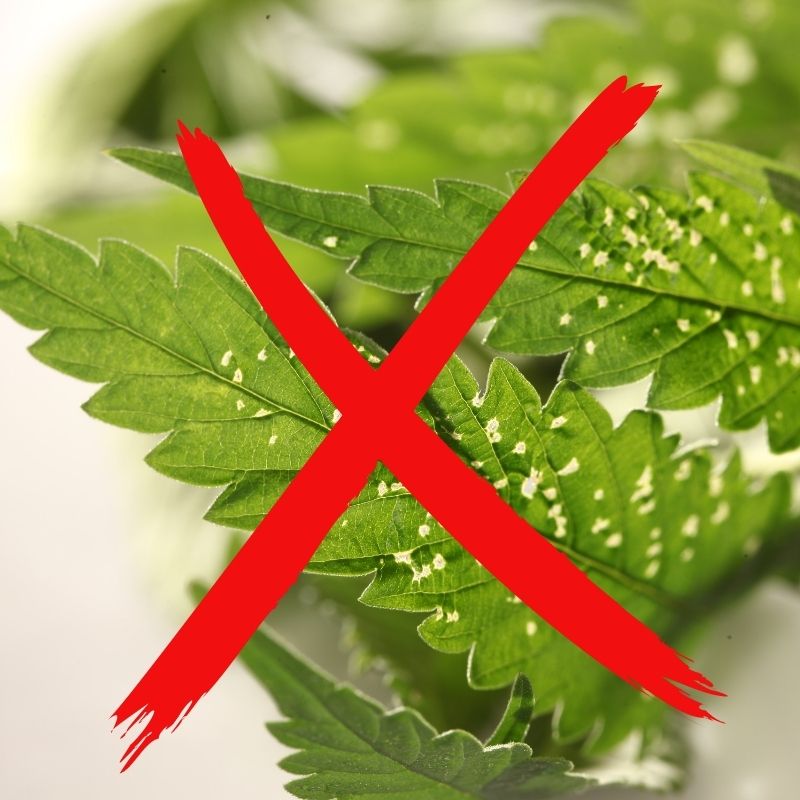
An infestation of insects and mites on your cannabis plants can be devastating. There are various types of harmful insects that damage your plants, some of the most common pests include spider mites, aphids, Thrips, and fungus gnats. Preventing an infestation in the first place is best but taking quick action when you notice an infestation is critical to saving your crop.
Identifying Predatory Pests
Identifying the harmful insect is critical, you should use a handheld magnifying lens and a quality pest ID booklet to make sure that you know your enemy. Introducing predatory insects is a practice best applied before a pest problem becomes a full-blown infestation. Stay vigilant, check your plants daily and be sure to check the underside of leaves where pests frequently like to hang out.
Spider Mites
There are thousands of different species of mites although they generally fall into two types, mites that require an animal host and those that require a plant host. Plant host mites pose serious problems to plants including cannabis, and one of the peskiest predators is the spider mite. There are many different subspecies of spider mites although they all cause the same damage and the control measures are similar.
You can identify a spider mite infestation by the telltale webbing that is left behind. By the time you see this, however, it can be difficult to control. Spider mites suck juices out of plant leaves causing damage and stippling that can lead to leaf drop and bronzing. Curled and burned leaf edges or leaves that have a leathery texture are all signs of a spider mite infestation. Webbing occurs when the infestation population has grown in size and can be visible on stems, foliage, and buds.
Introducing beneficial insects to biologically control spider mites can help to prevent an infestation once you have rid your garden of these harmful pests. Natural mite Predators include the Ladybug, the Green Lacewing, Assassin Bug, and Minute pirate Bug. Be sure to match the optimal conditions of your mite predator in conjunction with other integrated pest management methods.
Aphids
Aphids are another common garden pest that affects cannabis crops with detrimental effects. These sap-sucking insects are one of the most destructive pests for your cannabis garden. They are most commonly about 1 mm long and green in color, which can make them hard to see, but they can be black, white, or red and vary in length up to 10 mm. Aphid numbers can increase quickly as winged females hatch in early spring and birth more female nymphs which give birth to more nymphs in just a few weeks. They have two antennas and a pair of tubelike structures.
Aphids are typically located on the stems and leaves of cannabis plants and like to hide away from direct sunlight on the underside of the leaves. They suck the sap from your plants and leave a sweet, sticky substance called honeydew that leaves spots of mold and can also attract ants. Aphids cause leaves to wilt, curl, or yellow and will stunt your cannabis plant growth.
Quickly prune infested areas, hose your plants down with water or a water-vinegar solution to kill any remaining insects, and introduce predatory insects such as Ladybugs, Lacewings, crab spiders, and parasitic wasps which all naturally prey on aphids. Introduce these insects early in spring and again in late summer, if an infestation has already been detected it is typically too late to rely on predatory insects.
Thrips
Thrips are pesky creatures that are a common threat to cannabis growers and appear as little flying insects or worms. Thrips are hard to get rid of as they suck the sap right out of your plants. You can help to prevent Thrips by keeping your grow space clean and sanitary and removing all dead plant material. Using sticky adhesive flypaper is one of the best ways to catch these flying pests, you can also use organic pesticides like Spinosad.
Beneficial insects that are natural predators of Thrips include Lacewings, and Neoseiulus cucumeris, a predatory mite smaller than 1 millimeter long. Introduce predatory insects as soon as you detect thrips in your garden.
Fungus Gnats
Fungus gnats are tiny black bugs that you will see flying around and crawling close to the soil. They often appear from overwatering as the larva grows in wet soil and when topsoil stays too wet in between waterings. A couple of things you can do immediately is to place sticky flytrap cards in the grow area and place a fan to blow air on the top of your soil or grow medium. Make sure you stop overwatering your plants or you may never completely get rid of fungus gnats, although introducing beneficial insects can help to kill these pesky maggots. Predatory mites include Hypoaspis miles, Hypoaspis aculeifer, and pathogenic nematodes like the Steinernema feltiae.
The best way to deal with an infestation is to prevent it in the first place, although introducing beneficial, predatory insects and nematodes can help to keep these pests under control. Be sure to carefully read all product descriptions before introducing beneficial insects especially if introducing multiple predator species that can sometimes feed on each other.
Contact the horticulture experts at RainMakers Supply for any other questions on controlling infestations in your cannabis crop.
RainMakers Supply is a leading hydroponic grow store serving Chicago with a wide selection of high-quality growing supplies for personal or professional cultivation. We carry the best hydroponic growing supplies and equipment including grow media, nutrients, lighting, pest control, and more. Contact us with any questions on introducing beneficial insects to protect your garden.
